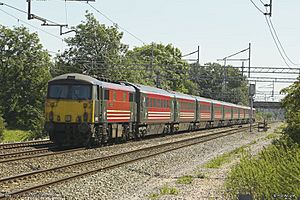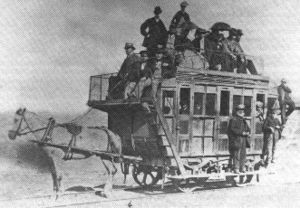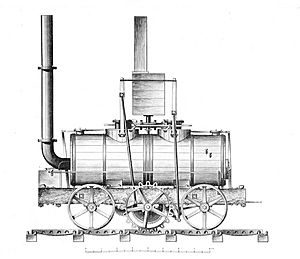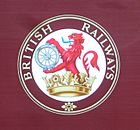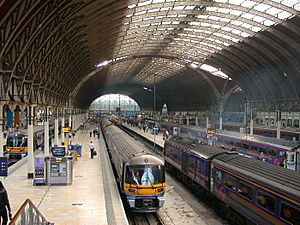History of rail transport in Great Britain facts for kids
This article is part of the history of rail transport by country series.
The railway system in Great Britain began with simple wooden tracks called wagonways in the 1560s. By the late 1700s, many small, private railway companies had their own local tracks. These small links grew into a national network during the exciting railway boom of the 1840s. Even then, dozens of companies ran the trains!
Over time, these companies joined together or were bought by bigger ones. By the early 1900s, only a few large companies were left. During World War I, the government took control of all railways. This showed how helpful it was to have one big plan for the whole network.
In 1923, almost all the remaining companies were grouped into four huge ones, known as the "Big Four": the Great Western Railway, the London and North Eastern Railway, the London, Midland and Scottish Railway and the Southern Railway. These companies ran the railways until the end of 1947.
From 1948, the "Big Four" became one big national company called British Railways. At first, things went well, and more people used trains. But by the late 1950s, fewer people were traveling by train, and the railways started losing money. This led to many railway lines and small stations being closed in the 1960s, a time known as the Beeching Axe.
In the 1970s, super-fast inter-city trains were introduced. Then, from 1994 to 1997, the railways were sold off to private companies again. Since then, more people than ever are using trains, but people still debate if this is because of privatisation. After a serious accident called the Hatfield rail crash, the company that owned the tracks, Railtrack, was replaced by Network Rail, which is owned by the state.
Contents
The First Railways: Before 1830
The idea of wooden tracks for carts started in Germany in the 1500s. But the first time steam engines were used on railways was in Britain. The earliest "railways" were straight wooden tracks where horses pulled carts.
Later, in 1793, Benjamin Outram built a track using L-shaped cast iron rails. Then, William Jessop made cast iron rails without the L-shape; instead, the cart wheels had special edges called flanges to keep them on the track. Cast iron broke easily, so in 1820, John Birkenshaw found a way to make stronger wrought iron rails, which were used from then on.
The very first public railway that carried passengers opened in 1807. It was the Oystermouth Railway, and it used horse-drawn carriages on an existing track.
In 1804, Richard Trevithick designed and built the first steam engine to run on smooth rails.
The first steam engine that made money was Salamanca, built in 1812 by John Blenkinsop and Matthew Murray. This engine used a special gear system with cogs to move along the track.
In 1813, William Hedley and Timothy Hackworth designed Puffing Billy. This engine had connected wheels, which gave it better grip. A year later, George Stephenson improved this design with his engine Blücher.
Stephenson's design impressed the people planning the Stockton and Darlington Railway. They hired him as the engineer in 1821. The railway was first planned for horses, but Stephenson changed the route so steam engines could be used. The law was also changed to allow passengers on the railway. The 40 km (25-mile) line opened on September 27, 1825. With Stephenson's Locomotion No. 1, it was the world's first public railway to use steam engines.
Growing the Network: 1830 – 1922
In 1830, the Liverpool and Manchester Railway opened. This railway set the standard for modern train travel. It was the world's first railway connecting two major cities for passengers. It also had regular schedules and proper stations, just like today. The railway carried both goods and people. It even had the world's first goods station at Liverpool's south docks, reached by a long tunnel.
Many early public railways were small, local lines run by private companies. Railways grew very quickly, especially in the 1840s. In 1840, there were only a few scattered lines in Britain. But within ten years, a huge network was built, and most towns and villages had a train connection. Over time, many of these small companies joined together or were bought by bigger ones. This led to only a few large companies remaining.
During this time, the government started to get more involved, especially with safety. In 1840, the "Act for Regulating Railways" allowed the government to appoint railway inspectors. These inspectors looked into accidents and suggested ways to prevent them. By 1844, a law was proposed to have the state buy the railways, but this didn't happen. However, it did lead to rules for building carriages and making sure there were cheap "Parliamentary trains" for third-class passengers.
During World War I, the government took control of the entire railway network. This showed the benefits of having all railways work together. But after the war, the government decided not to officially take over the railways completely.
The Big Four Era: 1923 – 1947
On January 1, 1923, almost all the railway companies were grouped into the Big Four. These were the Great Western Railway, the London and North Eastern Railway, the London, Midland and Scottish Railway and the Southern Railway. These were private companies that continued to run the railway system until the end of 1947.
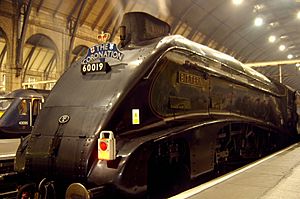
In the 1920s and 1930s, more people started using roads, which meant less money for the railways. The train companies felt it was unfair because the government built roads with taxpayer money, but restricted how much train companies could charge. The government looked into this, and a report in 1933 suggested that road transport should pay more taxes to fund the roads. It also noted that many small train lines would struggle to compete with road travel. Even with these changes, the railways slowly declined because there wasn't enough money invested, and people's travel habits changed.
During World War II, the railway companies worked together as one to help the country's war effort. This put a lot of stress on the railways, and they needed a lot of repairs afterwards. After 1945, the government decided it was best for the railways to be owned by the public.
British Rail: 1948 – 1994
From 1948, the railways were taken over by the government to form British Railways (later called "British Rail"). At first, not much changed, but more people used trains, and the network became profitable. By 1954, all the tracks and stations were repaired. However, by 1955, the railways were losing money again.
In the mid-1950s, new diesel and electric trains were quickly brought in to replace steam engines. This was part of a big plan to make railways better, but people didn't switch back from roads to trains as expected, and losses grew. This led governments to limit money for railways and look for ways to save money by cutting services.
To save money, a big part of the railway network was closed in the mid-1960s. Dr. Richard Beeching was asked by the government to reorganize the railways. This plan, known as the Beeching Axe, closed many smaller lines and stations that were not making enough money. This meant many rural communities lost their train services. It also meant that big industries like coal and iron started using roads instead of trains to move their goods. These closures were very unpopular then and still are today.
The number of passengers slowly went down from the late 1950s to the late 1970s. But then, train travel became popular again with the fast InterCity 125 trains in the late 1970s and early 1980s. In the 1980s, the government cut funding, and ticket prices went up, but the service became more efficient.
British Rail's InterCity service became profitable. It was one of Britain's top companies, offering city-to-city travel across the country, from Aberdeen in the north to Penzance in the south.
Between 1994 and 1997, British Rail was sold to private companies. A company called Railtrack took over the tracks and railway structures. Passenger services were given to 25 different private companies, and freight services were sold completely. The government at the time said that this change would make train services better. Since then, the number of passengers has increased a lot.
Modern Railways: 1995 Onwards
Since the railways were privatised, the number of passengers has grown quickly. By 2010, more people were using trains than at any time since the 1920s. By 2014, passenger numbers were at their highest ever, more than doubling in 20 years. However, train tickets now cost more than they did under British Rail.
Railways have become much safer since privatisation and are now the safest in Europe. However, the public's view of train travel was affected by some serious accidents shortly after privatisation. These included the Southall rail crash and the Ladbroke Grove rail crash, both caused by trains passing red signals. Another was the Hatfield rail crash, caused by a rail breaking due to tiny cracks.
After the Hatfield accident, Railtrack, the company that owned the tracks, had to put in over 1,200 temporary speed limits and start a very expensive program to replace tracks across the country. This caused big delays and cost a lot of money, which led to Railtrack collapsing. It was then replaced by Network Rail, a company owned by the state that doesn't aim to make a profit.
Images for kids
-
Frith's painting of Paddington railway station in London



